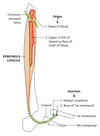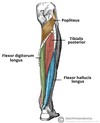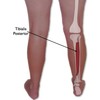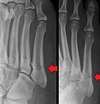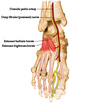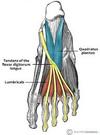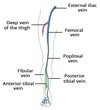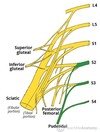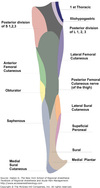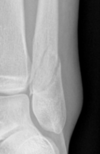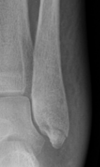Lower limb Flashcards
Borders of the femoral triangle
superior - inguinal ligament
lateral - medial border of sartorius
medial - medial border of adductor longus
floor - pectineus, iliopsoas and adductor longus
root - fascia lata

Content of femoral triangle
Femoral nerve
Femoral artery
Femoral vein
Femoral lymph nodes/canal

What is the femoral sheath?
Continuation of the fascia lining the abdomen
Anterior wall - continuous with fascia transversalis
Posterior wall - continous with fascia iliaca.
Sheath surrounds the femoral vessels and lymphatics for about 2.5cm below the inguinal ligament.

Content of femoral sheath
Femoral artery, vein and canal

Borders of Femoral canal (femoral ring)
Small medial compartment of the femoral sheath.
At the superior aspect is called the femoral ring:
Roof - inguinal ligament
lateral - femoral vein
medial - lacunar ligament
floor - pectineal ligament

Content of femoral canal
lymph nodes (femoral hernia)
How does a femoral hernia present?
Femoral hernia get hernial sac passing down femoral canal pushing septum (forms opening of femoral ring) before it
When passes out of bottom end of femoral canal forms a swelling in upper part of thigh deep to fascia
Swelling will lie below and lateral to pubic tubercle
Borders of adductor canal/hunter’s canal
Runs from apex of femoral artery to opening in adductor magnus.
Floor - adductor longus and magnus
Lateral - vastus medialis extends from the apex of femoral triangle to adductor hiatus
Sup: from apex Fem triangle
Inferiorly - adductor hiatus in adductor magnus

Content of adductor canal / hunter’s canal
Femoral artery
Femoral vein
Saphenous nerve
Terminal part of obturator nerve

Borders of Popliteal fossa
Inferior - 2 heads of gastrocnemius and plantaris
Lateral - biceps femoris
Medial - semimembranosus floor - posterior joint capsule
Roof - popliteal fascia

Content of popliteal fossa
popliteal artery
popliteal vein
tibial nerve
common peroneal nerve
Popliteal lymph nodes

What is the relationship of structures at the popliteal fossa?
Tibial and common fibular nerves (follows biceps femoris tendon) - superficial
Small saphenous vein
Deepest structure is the popliteal artery

Hip joint
Ball and socket joint, articular cartilage
Acetabulum (pubis, ischium, ilium) and femoral head
3 ligaments:
- *Pubofemoral** (superior pubic rami to intertrochanteric line)
- *Ischiofemoral** (ischium to greater trochanter) - weaker point
- *Iliofemoral** (AIIS to intertrochanteric line) - strongest point ligament of head of femur (contains a branch of obturator artery)
medial circumflex femoral artery (branch of profunda femoris) supplies the femoral head

What does the sacrotuberous ligament connect?
Connects the back of the sacrum to the ischial tuberosity

What does the sacrospinous ligament connect?
Connects back of sacrum to spine of ischium

Hip muscles - superficial abductors and extensors
Gluteus maximus
Gluteus medius
Gluteus minimus
Tensor Fascia Lata

Gluteus maximus
origin - posterior surface of Ilium, sacrum, coccyx
insertion - Gluteal tuberosity of the femur, fascia lata
innervation - inferior gluteal nerve action

Gluteus medius
origin - iliac crest
insertion - lateral surface greater trochanter of femur
innervation - superior gluteal nerve
action - abductor, internal rotation
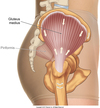
gluteus minimus
Origin- ilium
insertion - anterior greater trochanter of femur
innervation - superior gluteal nerve action - abductor hip, internal rotation
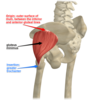
Tensor fascia lata
origin - anterior iliac crest, ASIS
insertion - iliotibial band ( which extends to popliteal fascia, lateral condyle of tibia)
innervation - femoral nerve
action - abductor and internal rotation
Role in tensing FASCIA LATA

Attachment of fascia lata
Posterior - sacrum and coccyx
Lateral - iliac crest
Anterior - inguinal ligament, superior pubic rami
Medial - Ischiopubic rami, ischial tuberosity , sacrotuberous ligament
Distally - lateral tibial condyle

What is the role of the fascia lata in the leg?
Gives rise to three intermuscular septa that attach centrally to the femur.
The septa divide the thigh musculature into three compartments;
anterior
medial
lateral
The lateral intermuscular septum is the strongest of the three due to reinforcement from the iliotibial tract

Hip muscles - deep lateral rotators
Piriformis
Gemelli
Obturator internus
Quadratus femoris
Piriformis
origin - anterior surface of sacrum
insertion - greater trochanter of femur
innervation - nerve to piriformis
action - lateral rotation, abduction passes through the GREATER sciatic foramen

Gemellus superior and inferior
origin - ischial spine and inferior from ischial tuberosity
insertion - greater trochanter of femur
innervation - nerve to obturator internus and quadratus femoris
action - lateral rotation

Obturator internus
origin - Internal surface of obturator membrane and posterior bony margins of obturator foramen
insertion - greater trochanter of femur
innervation - nerve to obturator internus
action- lateral rotation passes through the LESSER sciatic foramen

Quadratus femoris
origin - Ischial tuberosity
insertion - quadrate tuberosity on the intertronchanteric line
innervation - nerve to quadratus femoris
action - lateral rotation

Contents of greater sciatic foramen
(Suprapiriform and infrapiriform)
Supra Piriform foramen
Superior gluteal artery, vein and nerve
Piriformis
- *Infrapiriform foramen**
- *P** osterior cutaneous nerve of thigh
- *I** nferior gluteal artery and nerve
- *N** erve to quadratus femoris
- *P** udenal nerve
- *I** internal pudenal artery and vein
- *N** erve to obturator internus
- *S** ciatic nerve

Content of lesser sciatic foramen
Pudendal nerve
Internal pudendal vessels
Nerve of obturator internus
Tendon Obturator internus

Greater sciatic foramen
Anterolaterally - greater sciatic notch of ilium
Posteromedially - sacrotuberous ligament
Inferiorly - Sacrospinous ligament
Superiorly - anteriror sacroiliac ligament

Lesser sciatic foramen
Anterior - tuberosity of ischium
Superior - sacrospinous ligament
Posterior - sacrotuberous ligament

Anterior compartment of thigh

Iliacus
origin - anterior surface of Ilium
insertion - lesser tubercle of femur
innervation - femoral nerve
action - flexor

Psoas major
origin - Transverse process of L2-4
insertion - lesser tubercle of femur innervation - L1-L3
action - flexor
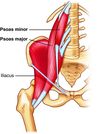
Vastus lateralis
origin - greater trochanter and lateral lip of linea aspera
insertion - patellar tendon
innervation - femoral nerve
action - knee extensor

Vastus intermedius
origin - anterior and lateral surface of femoral shaft
insertion - patellar tendon
innervation - femoral nerve
action - knee extensor

vastus medialis
origin - intertrochanteric line and medial lip of linea aspera
insertion - patellar tendon
innervation - femoral nerve
action - knee extensor

Rectus femoris
origin - Acetabulum and AIIS
insertion - patellar tendon
innervation - femoral nerve
action - hip flexor and knee extensor

Sartorius
origin - ASIS
insertion - Superior medial surface of tibia
innervation - femoral nerve
action - hip flexor, lateral rotation, knee flexor

Pectineus
origin - Pectineal line on the anterior surface of pelvis
insertion - pectineal line inferior to lesser trochanter
innervation - femoral nerve
action - adduction and hip flexion

Muscles in the medial compartment of the thigh

Adductor magnus
origin - inferior pubic rami & ischial tuberosity
insertion - linea aspera, adductor tubercle/medial supracondylar line of femur
innervation - obturator and tibial
action - adduction

Adductor longus
origin - pubis
insertion - linea aspera
innervation - obturator nerve
action - adduction, medial rotation

Adductor brevis
origin - pubis and inferior pubic rami
insertion - linea aspera
innervation - obturator
action - adduction

Obturator externus
origin - obturator membrane
insertion - greater trochanter
innervation - obturator
action - lateral rotation

Gracilis
origin - inferior rami and body of pubis
insertion - medial surface of tibia, between sartorius and semitendinosus
innervation - obturator
action - adduction, flexion of knee

Muscles of posterior compartment of thigh
Bicep femoris
Semimembranosus
Semitendinosus

Biceps femoris
origin - Ischial tuberosity (long head), short head = linea aspera
insertion - Head of fibula
innervation - short head : common fibular nn, long head: tibial portion sciatic nn
action - flexion of knee

Semimembranosus
origin - ischial tuberosity
insertion - medial tibial condyle
innervation - sciatic nerve/tibial
action - flexion of knee

Semitendinosus
origin - ischial tuberosity
insertion - medial surface of tibia
innervation - sciatic nerve/tibial
action - flexion of knee
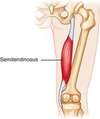
Proximal Femur
Head - joint with acetabulum with ligament teres
Neck - common fracture line
Greater trochanter - gluteal, lateral rotators
Lesser trochanter - hip flexors intertrochanteric line = becomes pectineal line posterior to lesser trochanter

Shaft of femur
Linea aspera - attachment of adductor muscles
Gluteal tuberosity
Medial supracondylar line = adductor tubercle

Distal femur
Condyles - articular surface of knee joint
Epicondyles - attachment for ligaments and muscles
Intercondylar fossa - ACL (lateral), PCL (medial)

Knee joint
Hinge joint, synovial joint
Joint capsules Bursa = Infrapatella, Suprapatella, subpatella, semimembranosus bursa
Ligaments - medial collateral (semimembranosus lies underneath), lateral collateral, ACL/PCL, patellar
Meniscus - medial C shaped (attached to medial collateral), lateral circular

Anterior compartment of the lower leg
Tibialis anterior
Peroneus tertius
Extensor hallucis longus
Extensor digitorum longus


